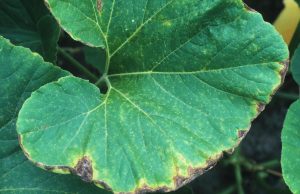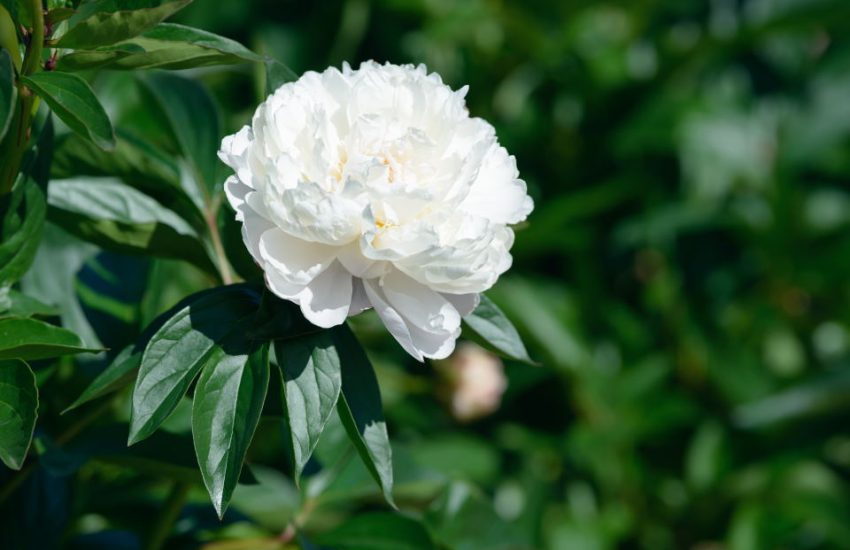Why Are My Pumpkin Leaves Turning Yellow? – Reasons and Prevention
Pumpkin leaves turning yellow is a prevalent concern with gardeners. While dying pumpkin leaves are a frustration for growers, it’s not the end of the world for your pumpkin plant. This article will help you understand what can happen and how to fix this issue.
Pumpkins, like all squash plants, are very vigorous and will produce enormous vines. Because of this, they require a fair amount of room to grow. They also like especially rich soil and ample amounts of water.
Plants that suffer from a nutrient deficiency usually look stunted and appear weak. Yellowing leaves, on the other hand, can be caused by many factors and don’t necessarily mean your pumpkin plant suffers from a shortage of nitrogen or another key nutrient for plant growth. The most common cause is the overuse of fertilizers, especially at the beginning of the season. A lack of proper watering, too much or too little nitrogen, and other factors do not cause yellow leaves.

A lack of calcium in soil often causes stems to turn yellow on a pumpkin plant. Calcium is needed for healthy root development and the formation of fruit. The soil pH must also be kept close to 6 or 7 to promote strong root systems.
If you notice that the stems on your pumpkin plant are beginning to turn bright yellow and feel brittle to the touch, it might indicate that the stems are rotting due to wet or poorly drained soil. Adding more compost or other organic material should solve the problem. Pumpkin leaves turning yellow is often a sign of insect infestations, including spider mites, aphids, and white flies. These pests can all be identified by their webbing and small black specks.
There are several reasons that can make pumpkin leaves turn yellow:
- Not enough water
The most common reason for the cause of yellowing pumpkin leaves is a lack of water for the plant. Ideally, when pumpkins lack water, their leaves start yellowing and drooping and develop wilted leaves and vines that feel a little soft to the touch; these are indications that your plant needs more moisture to stay healthy and robust. Feeling the soil directly is the best approach to determine its moisture content; try to reach with your finger 2 inches of the soil; your pumpkin plants won’t survive if the soil feels completely dry to the touch.Solution: water deeply and frequently
Pumpkins are quick-growing plants that thrive in wet, well-draining soil. Pumpkins typically require one inch of water every week. Nevertheless, the sort of soil that you have will significantly play a role in determining the amount of water your pumpkins require. The amount of watering the pumpkins need depends on how sandy the soil is. Less watering is necessary if there is clay since clay tends to retain moisture. Therefore, take a close look at your soil to get a thorough idea of the clay/sand elements that your soil contains.
High sand content soil is very brittle and loose. Roll a small handful of damp soil between your hands to form a ball, then squish the ball to determine how much clay is in your soil. There is a significant clay component present if the soil forms a ribbon.
Purchase a sturdy soaker hose, then run the water for enough time to thoroughly saturate the ground. The design of a soaker hose keeps the leaves dry, preventing illnesses and scorching in hot weather and saving you time while manually watering your plants.
- Nutrient deficiency
A lack of nutrients in the soil may also be the reason for yellow leaves on pumpkin plants. Pumpkins need nitrogen, potassium for early vine growth and root development, and other minerals for various plat functions. Any shortages in these nutrients might result in the pumpkin plant and its fruit growing more slowly and its leaves becoming yellow.Solution: fertilizer application
Use the appropriate fertilizer at the growth stage of your pumpkin vine. For the greatest results, always follow the manufacturer’s directions for dilution and application of fertilizer as they come in various formulas and concentrations.
Before planting, add some manure or compost to the soil.
Use a nitrogen-rich fertilizer from germination until just before the flowers appear to promote healthy, green foliage. The best meal is blood.
Phosphorus is required once flowering has begun. So the finest fertilizer is bone meal.
- Lack of sunlightThe minimum daily amount of direct sunlight needed by pumpkins is six hours. Your pumpkin plants will grow slowly and develop yellowing leaves if they receive less light, which will prevent them from photosynthesizing the right amount of sugar.
Solution: Improve sunlight exposure
Increasing sunlight exposure might not be simple, especially if a building or tree is the problem. Give overgrown plants or shrubs a good trimming, and prune any large shaded branches. If the shrubs or bushes aren’t too big, you could also want to think about shifting them.
Don’t consider it a total loss, even if it isn’t much you can do about the sunlight exposure. You can decide where to plant your pumpkin plants after determining where your yard and garden receive the most sunlight.
- Genetic typeA pumpkin plant may occasionally have a few yellow leaves or stems, but it will still grow and bear pumpkins. There are no additional issues, such as dying or wilting plants, browning leaves, or abnormal growth of pumpkins.
Solution: Monitor Growth
A “precocious yellow” or genetic difference in the pumpkin plant might be the only explanation why your pumpkins are turning yellow. It’s primarily aesthetic, so there’s no need to worry.
- Pumpkins DiseasesPumpkins may be affected by common plant diseases such as Verticillium wilt, Downy mildew, and bacterial wilt.
Yellow patches on the tops of leaves and fuzzy, gray growth on the undersides are the symptoms of downy mildew. Although the pumpkin plant will eventually die, verticillium wilt can lighten the color of the roots and stems to a pale brown.Solution: Destroy the affected plant or treat the disease
Check the pumpkins to determine how far along the illness is if you have downy mildew. Removing the few infected leaves will allow you to spray the other leaves with a copper fungicide or a solution of 1 tablespoon baking soda to 4 cups water.
The best action for pumpkins with extreme downy mildew infection is to uproot the plant and throw it away.
You will, regrettably, be unable to preserve your pumpkin plant if verticillium wilt or sudden wilt is the issue. Pull it out immediately and throw it in the garbage instead of composting or burning it.Adhere to the following tips to prevent your pumpkins from diseases:
- If you grow pumpkins every year, switch up the location of your patch. Some illnesses are present in the soil, ready to infect a new crop of pumpkin plants.
- Don’t overwater, and don’t water so much that the leaves become moist.
- Space out your pumpkins (or any garden plants, for that matter). When too many plants are in one place, the natural airflow is stifled, and sunlight cannot reach the lowest leaves.
- Excessive heat
65 to 95 degrees Fahrenheit is the ideal temperature range for pumpkin development. It might occasionally be difficult to promote their growth, depending on your USDA hardiness zone. Pumpkin vines may struggle and begin turning their leaves yellow if daily high temperatures are over 95 degrees for an extended period.Solution: water, shade, and mulch your pumpkins
Although you have no influence over the weather, you can make certain adjustments to the environment of your pumpkin field. Try these methods to assist your pumpkin plants in surviving the hot period if temperatures are getting too high for them:
- Water your garden more frequently. High temperatures cause more water to evaporate and hasten soil drying.
- Cover pumpkin plants with mulch. Mulch helps keep soil temperatures a little bit lower and maintains soil moisture levels between watering.
- Think about introducing temporary shade. During the warmest portion of the day, some dark garden cloth or a tarp placed across several garden pegs can offer some much-needed shade.
- Insect attacksInsect infestations might also bring on pumpkin leaf yellowing. Squash bugs and squash vine borer are the two most prevalent pests.
Similar to stink bugs, squash bugs assemble on the undersides of leaves. They lay little, spherical, red eggs that are grouped on the undersides of leaves.
A squash vine borer is a black bug with transparent, metallic-green wings and an abdomen with orange or red spots. The squash vine borer’s inch-long, white to gray larvae will eat their way through the stems of pumpkins.
Solution: Treat infestations
Take a bucket of soapy water to the pumpkin patch and manually knock the squash bugs into the water to get rid of them. Turning the leaves over to have a good look below can let you thoroughly inspect each pumpkin plant.
Remove and destroy any eggs you find. Keep the garden tidy to avoid squash bug issues in the future. The greatest defense against a squash bug infestation is to remove dead plant material and leaves.
Additionally, planting your pumpkins early in the season might aid in preventing damage from squash bugs. Early to mid-summer is when squash bugs often attack; more developed plants are better equipped to endure an onslaught. Sadly, you might be unable to salvage your pumpkin plants if squash vine borer larvae are already feasting on them.
If you still believe the infestation is in the early stages, you can take the following actions:
- Cut a shallow slit up the harmed stem with a sharp knife. You’re hunting for the larva; if you find one, carefully remove it and discard it.
- Since there are frequently several larvae in a stem, keep cutting slits and extracting the larvae until you find healthy plant tissue.
- Carefully place new soil over the sliced stem. Hopefully, the pumpkin plant’s buried stem part will sprout new roots.
You may catch squash vine borer moths for eradication by luring them to yellow pots with water. The squash vine borer is naturally preyed upon by braconid wasps; therefore, cultivating flowers with numerous little blossoms is a fantastic strategy to draw them. When the adult squash vine borers are active in the middle of the summer, you may also cover your pumpkin vines with a thin piece of fabric for two weeks.
- End of natural life cycle
Your large, vibrant pumpkins are getting close to the conclusion of the growing season, but the leaves are beginning to turn yellow, and the vine appears to be beginning to dry out and die, as well.Solution: Get ready to harvest
Your pumpkins are usually ready for plucking when the leaves begin to turn yellow, and the vine begins to dry out and die.
It’s ready to harvest your pumpkins if you touch one, and the skin is brilliant orange and firm.
However, you shouldn’t assume that all of your pumpkins are ripe just because one of them is. Before harvesting, inspect each individual pumpkin because they might mature at slightly different periods.
Conclusion
Although they have numerous purposes and are a pleasant plant to cultivate, pumpkins occasionally exhibit some finickiness. Yellowing pumpkin leaves do not indicate the onset of mortality; rather, it indicates that something is occurring that probably requires attention. With the help of the aforementioned advice, you should be able to identify the causes of your pumpkin leaves becoming yellow.


